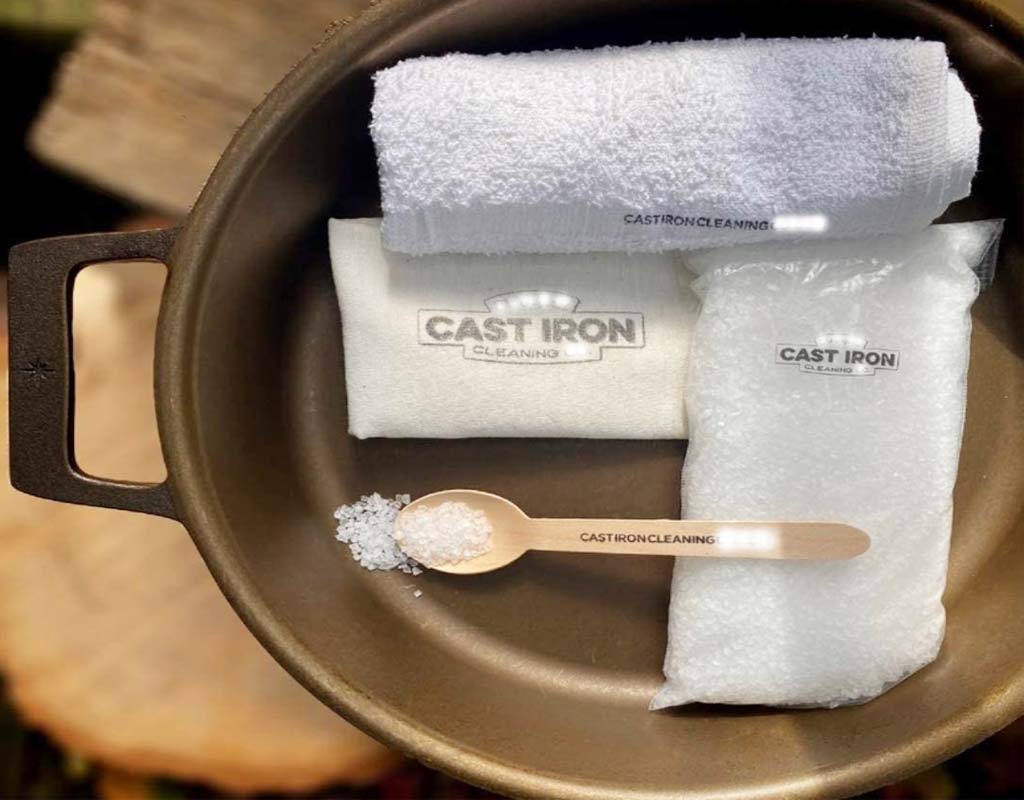Are you being faced with difficulties on how to clean cast iron cookware and re-season your rusting skillets and pots? In this article, we have made the task pretty easier for you. We have researched deeply the most effective methods for you to use while cleaning your cast iron cookware without damaging it. You will comfortably remove food stains, rust, black residue, and sticky fats from your cookware surface without difficulties.
We have selected various cast iron cookware and tested the effectiveness of different cleaning detergents to ensure that we select the most effective and efficient for you. We have also listed the different methods you can apply to clean your cast iron cookware without damage. There are also ways of handling cast iron cookware that cause damage and we have listed them, for you to avoid them and keep your cookware for a longer lifespan.
There are also devices you can use to clean your cast iron cookware the leave them sparkling clean and to re-season them. All your skillets and pots that look rusty and have a black residue will turn shiny again when you practice our methods. Our research team is dedicated to making your life in the kitchen much easier and enable you to make happy meals.
Keep reading to enjoy the great ideas that we have researched for you to help you clean cookware though without a dishwasher, with much ease and comfort. The following methods are used for each type of dirt on how to clean cast iron cookware
To remove food stains
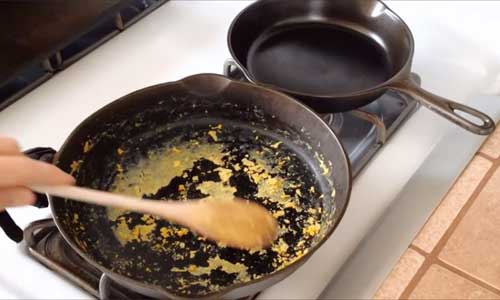
You have to be careful not to use materials that will scratch your cookware surface and expose metals to your food. Abrasion will also make your cookware surface wear out and exposed to rusting since it is made of cast iron. This means that you should avoid using steel wool or metal scrubbers while cleaning cast iron cookware. Follow the following steps to keep your cookware sparkling clean and well-seasoned.
Use a scrub brush that is specifically designed for cast iron. It is sturdy and will remove stuck-on food without being rough on your cookware surface and exposing the inner layers. A full tenacious C cast iron round brush is the most effective and ideal for this task. While cleaning, avoid soaking the pan in water since it will rust easily. Remove it and dry it well before storage.
- Clean the cast iron pot or skillet right away from taking it off the stove top when still hot. Do not allow it to cool down or leave it in water.
- Use hot water to clean with a sponge or a stiff cast iron brush. Using soap is not recommended since it can scrub the seasoned surface. You should also avoid the dishwasher and steel wool.
- Coarse kosher salt should be used to scrap off food stuck on your cookware surface. Use the paste and then wipe your cookware to dryness using paper towels. Any stubborn foods that stick on cast-iron cookware surface should removed with boiling water but not soaps.
- The skillets and pans should then be dry toweled and then super dried on a stove over low heat.
To remove rust
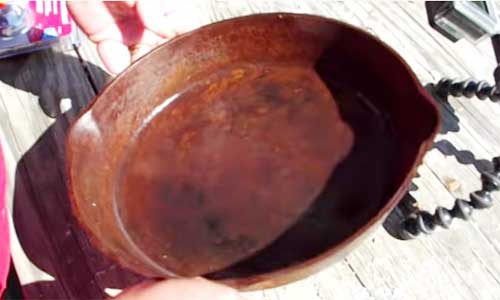
This will involve scrubbing the rusted surface using scrubbers and vegetable oil of your choice. For rusted surfaces, metal scrubbers and steel wool are allowed. Scour the pans and skillets until the rusted part is returned to raw cast iron. You will then take another step to wash with mild dish soap to perfection and keep everything sparkling clean. Scrub using gentle mesh sponge, gentle scouring pad and bristle brush if needed. You then dry the cast iron cookware skillet or pot with a paper towel or clean dis towel.
Use the vegetable oil or any other favorable cooking oil for you to smear all the parts of your pots or skillet. Do the same to the bottom part of your cookware and the handles for uniformity. Place the cast iron cookware parts on the top of your oven and place them upside down. Having a foiled lined baking sheet or aluminium foil will be ideal to preventing tricking of oil on to the bottom parts of your oven. You should then heat your cookware at 350˚F.
To remove sticky fats
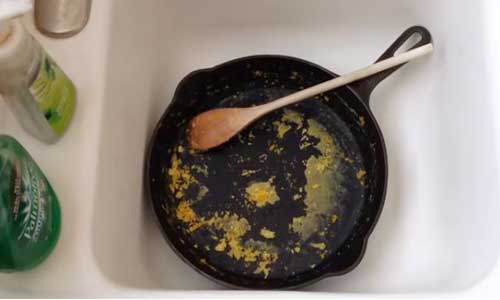
Cast iron cookware should not be kept with any sticky fats on its surface since it will collect stains and reduce the efficiency of the cookware as well as the quality of meals produced. Cast iron cookware can be added a coating of enameled surface to keep it nonstick but some fats will still keep on the surface even after cooking a meal. You should therefore clean the cast iron cookware immediately after coking when hot to ensure all the stains are removed from the surface. Follow the following steps on how to clean cast iron cookware and free of sticky fats and oils on the surface.
- Hand washing is the safest and most efficient method for you to clean your cast iron cookware. Avoid commercial soaps, dishwashers, and metal scrubbers.
- Use an approved cast iron pan scrapper and scratch gently to ensure all the fats detach from the cookware surface.
- You can then simmer a little water in the cast iron pan for about 5 minutes and scrub the surface to remove all the stubborn stains and particles. You can use a little bit of dish soap to make cleaning more effective and easier.
- Once you have washed the cast iron pans and skillets, rinse them with clean water free of any detergents and salt. Take a keen look at the cookware surfaces and ensure they are all sparkling clean including the handles.
- After rinsing, use a paper towel or a lint-free clean cloth to dry all the surfaces of the cookware. The little black residue that you will see is just but a little seasoning.
- When your cookware is dry, store it in a dry place for the next use and ensure no water comes into contact with it to avoid rusting.
- You can oil the surface of your cookware to prevent direct exposure to a humid atmosphere in the kitchen. This will help avoid rusting. You rub a light cooking vegetable oil layer or a seasoning spray to keep your cookware surface protected. You then wipe the cookware again with a paper towel to keep free from all oil residues.
Check out also :
How to remove the black residue
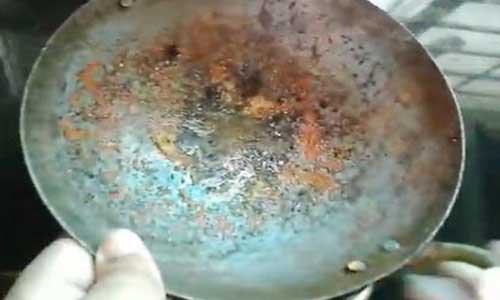
Black residue makes your cookware look dirty and can compromise the taste of your food. It will increase black spots on your food and even reduce the flavor when left to accumulate on your cookware. The accumulation is mostly dependent on the age of the skillets and also the usage frequency. It can also be brought about by charred food from previous meals that were overcooked and particles left stuck on the surface.
Burnt oil can also form a black residue and this mostly happens with oils of a low smoke point such as olive oil. IN brand new skillets, the manufacturer’s seasoning may leave black residues on the cookware surface. To prevent the build-up of black residue on the surface, it should be removed and a new seasoning process carried out to keep the cookware clean and deliver healthy, tasty meals. The black residue should not be left to stick in your clothes as it can leave stains difficult to wash.
You should ensure that all the nooks and crannies of your pan are well oiled to prevent the accumulation of black residues that will elude the taste and aroma of your food. This will keep the food free from sticking to the surface. You have to season the cast iron pans and skillets by smearing oil on their surfaces and then heating in the oven. This will make the oil bond to the surface of cast iron cookware through polymerization.
It will protect the surface and prevent foods from sticking onto it and in turn leave fewer black residues forming on your cookware. You should at all times avoid cooking subsequent meals with food stuck on the surface of your skillets. The residues formed after every meal will get charred and eventually form an embarrassing thick black residue on your cookware. There are several ways in which you can remove this black residue from your skillet.
The most popular method is the one that uses salt and soap. It does not damage the polymerized layer made from seasoning. Salt does a great deal in breaking down the oily black residue with ease.
To remove black residues from a cast iron pan or skillet using salt and soap, consider the following procedure.
- Put 3 to 4 spoonsful of salt into a cast iron pan or skillet. Add dishwashing soap that is commercially approved for cast iron cookware.
- Take a clean sponge mesh, dishwashing cloth, or a clean rag and scrub the cast iron pan or skillet with it when it is soapy.
- Warm or simmer some clean water and use it to clean the pan or skillet to a shiny luster. Use tour hands to scrub inside and ensure that all the pores on the cookware surface are free of the black residue and the soapy salt mixture.
- All the moisture should be dried with a clean lint-free cloth or a paper tea towel.
- You then place the dried skillet or pan in an oven under medium heat to remove the remaining moisture This will help in reducing the rusting probability of the skillets and pans as cast iron is quick to rust under humid conditions.
- Use some elbow grease to re-season the cast iron pans and skillets to keep them in good condition for long periods of time.
A self-cleaning oven can also be used to remove black residue on cast iron pans and skillets. This should be done carefully and it involves high heat of up to 880˚F. This high temperature makes the left-over food stuck on the cookware pans decompose and turn into ash. Consider the following steps to complete this process.
- The racks of the self-cleaning oven should be moved to the bottom.
- The cast-iron pan or skillet is placed upside down on the topmost shelf of the cleaning oven.
- The oven is then turned on over high heat for 4 to 5 minutes. Most self-cleaning ovens complete their cycle in 4 minutes and this is an ideal time for you.
- Once the oven automatically stops heating, take out the cast iron pan or skillet and allow it to cool.
- Let it cool until it is safe to touch and then scrub it to get rid of any black residue left over and decomposed ash.
- With this method, ensure you take precautions as you can easily burn your hands.
Like also: Best All Clad Cookware Sets Reviews and Guide of 2023
You can use other safe and approved detergents to clean your cast iron cookware.
Type of detergent to be used
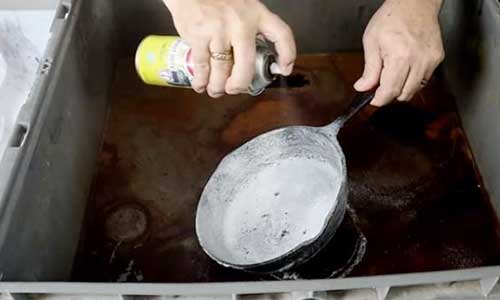
The best type of detergent to use in cleaning iron-cast cookware is soap-less detergent. Everyone understands that seasoning is the key to good cast iron. Re-season your cookware as needed with the super convenience to maintain it smoothly and, more importantly, do not forget to nonstick. A thin film of oil coats the inside of your cookware and is not good for seasoning. Because soap is designed to remove oil, it will harm your seasoning.
Therefore, any soap-less detergent designed for washing utensils is the type one should use. However, a tiny amount of soap can be used and, if necessary, scrape stuck-on food with a pan scraper.
You may like: Top 10 the Best Cookware Sets under 200
Can one use warm water?

Hand-washing your cast iron cookware with soap-less detergent is best when accompanied by warm water. Simmer with a little warm water for about four minutes to loosen stuck-on food, then scrape with the scraper when the pan has cooled. Warm water helps to remove the oil molecules from the iron-cast cookware easily.
To remove any food residues, rinse your warm but not hot cast iron pan in an empty sink under hot running water with a clean cloth or brush. Hot water will only hit up the cookware and makes it ineffective when mixed with soap. Use coarse salt as an abrasive to remove stuck-on or burned-on meals.
You may check out: Top 10 The Best Space Saving Cookware Sets Reviews and Guides
Is cast iron dishwasher safe?
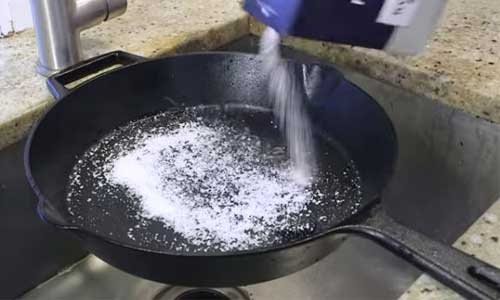
Cast iron cookware may be cleaned with a tiny amount of soap, contrary to popular opinion! Large amounts of soap will strip your pan’s seasoning, but you can easily re-season it as needed. After each usage, properly clean your pan with soap and water, cleaning out any dirt or debris from the bottom.
For this, I use the scrubby side of a sponge. Rust is a result of soaking cast iron in water. Use a nylon scrubbing brush or a pan scraper to remove sticky or hard stuck-on food, then rinse with warm water. Make sure your pan is completely dry before using it.
Read also
How to Use Non Induction Cookware on Induction Cooktop (2023)
What Cookware Does Gordon Ramsay Use? (2023)
How to Organize Your Refrigerator Properly for Food Safety in 2023
Best Uses of Nonstick Cookware-Tips for Beginner in 2023
Safety and Maintenance Tips to Take Care of Nonstick Cookware Sets
Do we use a towel or a dishcloth?
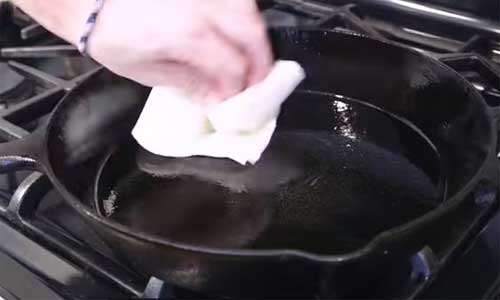
After carefully choosing the detergent and using warm water to clean and rinse the iron cast cookware, use a towel to dry it up instead of a dishcloth. If the pan is already well seasoned, dry it with paper towels and let it lie until it is bone dry, or lay it on a hot burner for a minute to dry it. Apply a thin coat of cooking oil or Seasoning Spray to the cookware’s surface. To remove any remaining oil, wipe the surface with a paper towel.
You May Like Also: Best Granite Stone Cookware Reviews and Guide of 2023
Ways to ruin your cast iron cookware
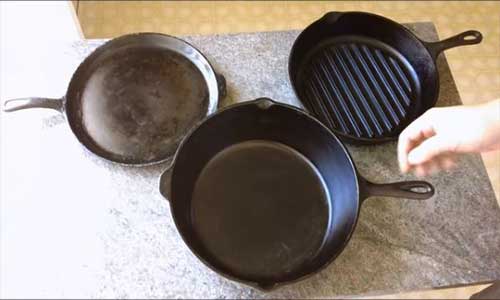
There’s a reason why you’ll find 75-year-old cast iron pans at yard sales and antique stores. It’s tough to damage the thing because it’s made to last entirely. Most new pans are even pre-seasoned, which means the hard work has already been done for you, and you can get right to cooking. To soak your cast iron cookware, do not immerse it in water. You’ll lose the seasoning and add too much moisture to the pan, causing it to rust.
If you’re going to wash the dishes in the sink, keep the cast iron out of it and use water wisely. It is almost important to note that soaking iron cast cookware in cold water will rust. Therefore, there are numerous ways that one can ruin iron-cast cookware, and some are;
- Scrubbing your cast iron with too much soap is also another way to ruin iron cast cookware. Cast iron cookware may be cleaned with soap, contrary to popular belief. It won’t damage the seasoning, but keep soap to a minimum, rinse well, and dry properly. Eliminating moisture is the most important way to preserve your cookware in good condition. However, it is recommended to use soapless detergent to wash these utensils to avoid ruining them.
- Another thing that ruins iron cast utensils is using a dishwasher to clean your cast iron. Don’t chuck your cast iron in the dishwasher to save time after supper. The worst thing that might happen to your iron pans is to have them blasted with water for an hour or more. As previously said, these utensils must be hand washed exclusively with soapless detergent to avoid being ruined.
- Washing iron cast cookware when still hot ruins them. While the pan is still hot, avoid rinsing it; instead, wait until it has cooled down before rinsing it with either cold or warm water. Your pan may break or deform as a result. To keep your cookware in good condition, heat your pan slowly and let it cool naturally. If the pan is still warm but not hot, it may be easier to remove any remaining stuck-on food.
- Failure to season these utensils more frequently might ruin the iron casts. One should not think that once you’ve seasoned your pan, you’re done. Seasoning is a never-ending process that must be maintained; the more you use your pan, the more frequently you must season it.
- Make sure your cast iron is completely dry and oiled before putting it away. After cleaning your cast iron, heat it on low in the oven or on the stovetop with a small bit of oil. Remove the pan from the heat, set it aside to cool, and blot up any remaining oil with a cloth.
- To clean your pan, don’t be scared to use salt. As previously said, using salt to remove dust and other filth from your pan without removing your seasoning is an excellent way to do so without destroying your seasoning.
Also, one needs to avoid cooking certain foods in these types of utensils. Foods like wine-braised meat, tomato sauce, and omelet dishes have acidic contents that might react with the iron casts used to make the cookware.
These basic care instructions are an important element of keeping your cast iron in good shape. With the ability to easily transition from the cooktop to the oven and cook a range of recipes, cast iron pans are the most versatile culinary utensil you will ever own. There are, however, some items that should not be cooked in cast iron.
- Tomato sauce/dishes based on tomatoes. Tomatoes are naturally acidic. When cast iron is exposed to acidic foods, some metals in the pan are broken down.
- These trace metals are absorbed into the dish you’re preparing, and though they’re reasonably safe for your health, they can provide a metallic flavor to your cuisine. The acid will also break down your pan’s seasoning. If you must add an acidic element to something you’re cooking in a cast iron pan, do so within 30 minutes and never, ever store your food in the pan afterward.
- Wine-braised meats, vinegar-based meals, and lemon-based meals are all acidic, so they’ll break down the pan in the same manner as tomato sauces do.
- Omelets are delicious. Eggs can stick to your pan, especially if it’s brand new and hasn’t been well seasoned. Your eggs will be damaged, and you’ll have to fight to get the egg residue off the pan, which may damage some of the seasonings you’ve applied. Eggs are best cooked on cast iron dishes or other pans that have been seasoned until they are very smooth to the touch.
- Fish that is delicate. Soft, flaky fish doesn’t hold up well to the heat a cast-iron skillet can emit. The fish will tend to fall to pieces and stick to the pan.
- Dessert. You can cook dessert in cast iron, but the pans tend to retain some of the flavors of the dishes you make. The flavor of the steak can quickly hinder a tasty dessert if you just cooked it in the pan. If you have multiple cast iron pans, you can reserve one for sweet dishes and one for savory. Unless you’d like to eat a burger-flavored fruit crisp.
Check out also:
Best way to restore cast iron cookware
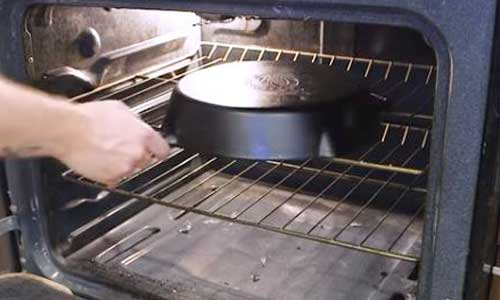
There’s a reason why cast-iron cookware is so popular: it’s durable. It can be used to cook almost anything on any surface, and the more you use it, the better it works (after time, it will develop a natural non-stick surface). It can last a lifetime if properly cared for, such as washing with a good salt rubdown rather than soap and water. If your iron-cast cookware has been ruined, there are still hopes of restoring it by following the following steps.
- Invert the pan in the sink and sprinkle with baking soda. Using a small amount of water, mist the area.
- Pour a few squirts of dishwashing liquid into the mixture.
- Scrub away rust and debris with a scrub brush. (A scrub brush, rather than a typical scrub pad, will allow you to get into the nooks and etchings on the bottom of the pan.)
- Scrub the pan clean with baking soda and a scrub pad.
- Thoroughly rinse and dry.
- You’ll need to re-season the pan because all that scouring removed the natural patina as well as the rust. Begin by rubbing a coating of shortening (such as Crisco) on both sides of the pan with a paper towel or rag.
- Place the pan upside-down on a big sheet pan and bake for one hour at 350°F in a preheated oven.
- After an hour, turn off the oven and leave the pan within until absolutely cold before removing it.

